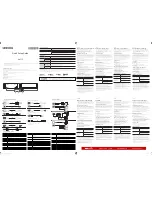
28
3) Oranges, small pomelos
* If the item is too soft, hold the item with your hand gently after pressing the start button.( See page 35)
This is to prevent the machine damage caused by the item falling off.
Article
Recommended Settings & Procedures
Explanation
Holding Prong
HP-MO
Optimal
Peeler blade
F-3, F-4
To remove only flavedo (outer skin)
S-1, S-2
To remove albedo (inner peel)
Settings
Skin Thickness
4~6
Adjust to the thickness of flavedo.
0~5
Adjust to the thickness of albedo.
Spin Speed
4~6
Adjust this setting to according to the firmness of
fruit.
Specific settings
Peeling range,
angle
L to R
0°
180°
10°– 160°
To remove outer (flavedo) skin only
0°
180°
20° 140°
~-
~
30° 170°
To remove the inner (albedo) skin
Peeling Direc
-
tion
L < R
To prevent the fruit from slipping off the prong
Peeling Throw
Yes
When peeling the outer skin only
None – half
When removing the inner (albedo) skin
Peeling Finish
Normal
Optimal
Preparation
None
When removing flavedo only.
Lop off the top skin of the fruit until the
meat can be seen.
Remove the inner skin (albedo)
Slice off
Make a vertical score (cut) to reduce
fouling of the blade during peeling.
The thickness of the inner (albedo) skin can vary.
Adjust the peeling depth as needed.
Fixing Direction
Insert the prong through the top of the
fruit.
Removing a small part of the fruit apex,
such as that on a navel orange, will facili-
tate mounting of the fruit on the prong.
Optimal
●The most efficient method of peeling the albedo is to remove the top of the orange and separate
the fruit based on the thickness of the albedo (which differs from fruit to fruit.)
●It is recommended that the procedure of
page 29 “How to skillfully peel citrus“ be used to
skillfully peel oranges and small pomelos.
Содержание KA-700H
Страница 39: ...38 MEMO ...












































